The South Central Telehealth Resource Center (SCTRC) has always had a mission to provide education, training, and telehealth technical assistance. Although the global pandemic increased demand and brought extra challenges, the SCTRC continued to do what it does best: provide assistance with tools and skills to help interested individuals and organizations better embrace and get compensated for telehealth services.

Regional Training Centers
The SCTRC has operated a telehealth training center in cooperation with the University of Arkansas for Medical Sciences (UAMS) Institute for Digital Health & Innovation (IDHI) as its digital innovation partner for years.
“We want to give providers the opportunity to touch, feel, and envision how they could incorporate telehealth technologies in their practice,” said Wendy Ross, co-director of the SCTRC. “A place where they could consider whether they want wired or Bluetooth devices? Do they want a high-end stethoscope or would a smaller, portable model do? What kind of sound quality do they need? They could think about all of these things and more here in a no-pressure, no-sales environment. Recently, we updated the center with new remote patient monitoring (RPM) devices as well as some wearables.”
Since COVID limited the ability for providers to travel as easily, the SCTRC began opening similar centers in different regions of its territory. “We wanted to start by reach the northwest area of the state where we have several underserved populations with chronic medical conditions,” she added.
Besides being open for area providers to come in and try telehealth devices, organizations were invited to bring in groups for special training sessions. “For those providers who can’t get to a training center due to COVID, job demands, or budget, we put together telehealth demonstration kits that will soon be available to loan those interested,” Ross said. “We’ll ship these kits to them so they can try everything out, and we’ll train them virtually on how to set the kids up and use them through self-guided online tours. When they’re done, send them back. We wanted to meet providers where they were and help them to start incorporating those technologies into their practices.”
Joe Schaffner, assistant director at the SCTRC, explained that the SCTRC created both pre-recorded training videos on telehealth 101 and etiquette topics, but also offered customized training. Providers have appreciated the opportunity to talk with IT professionals in addition to those experts on the clinical side of things.
Telehealth Consult Evaluation Tool
The UAMS IDHI, along with the SCTRC, is developing a telehealth video analysis program for training and evaluation. The clinical and technical teams developed a prototype to automatically gather information about a telehealth encounter and evaluate key metrics such as sentiment analysis, topics discussed, lightning quality, and sound quality, among others.
This system could be used to evaluate telemedicine encounters based on proven metric scores and best practices, provide feedback and training to healthcare or medical students, and help healthcare staff improve performance.
“This system provides better feedback for those participating in telehealth training sessions,” said Dr. Hari Eswaran, co-director of the SCTRC. “It can use both mock sessions or real sessions with patients, capturing the audio and visual feel of the session. It looks at both emotional and visual cues using an automated artificial intelligence algorithm and provides feedback on lighting, emotions, and facial expressions.”
Dr. Eswaran said that the system also works well for evaluating team care and interactions. “We could have many people on that call including dieticians, doctors, therapists, pharmacists, and others,” he said. “It’s a good way to evaluate team care.”
The system is in beta testing now, and the team is beginning to work with other institutions to expand its use.

Billing Guides and Training
One of the most popular technical assistance (TA) questions that SCTRC faced during COVID revolved around the rapidly changing billing issues. SCTRC began working with its billing experts to create comprehensive state-specific billing guides that were updated on a monthly basis.
Ross said many providers were confused about what they could bill for and which forms they were supposed to use. “Each funding agency can be different so we had to create pretty robust guides that provided very specific information for each,” she said. “We had to address specialties like speech and physical therapy, which couldn’t be billed before but could now, and things like phone consults. The billing guides were absolutely critical.”
Schaffner added, “We offered corresponding webinars to go with the guides and the key things that were happening with policy changes. Our rural providers faced big hurdles on the reimbursement side of things. We partnered with experts in billing, reimbursement, and overall revenue cycle management to put on these billing webinars.”
The SCTRC, has made these guides for Arkansas, Mississippi, and Tennessee easily accessible on the LearnTelehealth.org website, and share updates via social media channels, blogs, and newsletters.





